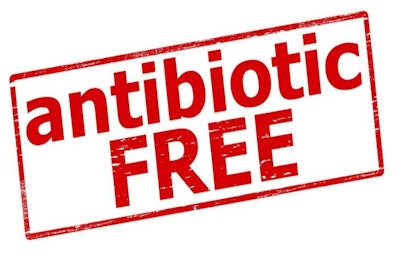
Going antibiotic free means growers need to be more mindful of the cleanliness of their operation and more cognizant of how feed and feed additives can promote the overall health of their birds.
That’s what Dr. Mahmoud Masa’deh, a poultry technical sales specialist and nutritionist with Purina Animal Nutrition L.L.C., recommended during his presentation at the Midwest Poultry Federation Convention in St. Paul, Minnesota. Masa’deh spoke as part of the March 16 Broiler Production workshop.
Masa’deh said pressure from consumers, along with regulatory changes, is rapidly pushing integrators and growers to reduce or totally remove antibiotics from broiler production. This change forces growers to be more careful about biosecurity and farm sanitation; litter management and downtime between flocks; the composition of feed; and which probiotics and other additives are included in feed.
Biosecurity and strict farm sanitation practices
Generally, raising birds without antibiotics requires a back-to-basics approach. Masa’deh said removing disease-preventing and growth-promoting antibiotics requires farmers to reduce the opportunities for birds to get infected at any stage of their life. This means paying close attention to the cleanliness of everything from the breeders to the hatchery to the feed mill to the barn itself.
Masa’deh said managing dust -- which can carry dangerous bacteria and mold around barns through the air -- in all stages of production is key. He said special consideration must be paid to dust and the overall cleanliness of the hatchery and pullet housing because exposure to negative microbes early in the lives of the birds can set a flock up for failure. If chicks are vaccinated, it’s important to make sure they receive optimal light to improve their vaccine uptake.
As for biosecurity, Masa’deh said having a plan in place and keeping an eye on potential disease vectors can be the difference between success and failure.
“I view it as a profit or loss,” Masa’deh said. “If you keep your birds secure, you get money. If you don’t, you lose a lot.”
Litter management and downtime
Another key factor in keeping a sanitary operation is the maintenance of litter in the barn and taking enough time in between flocks.
He recommended establishing a strict downtime program with growers, requiring them to remove the birds and the litter and take at least 14 days before putting new birds in. This must be done to ensure the products applied to combat harmful microbes have enough time to work. When birds are in the house, increasing the stocking density by at least 0.05 square feet of space per bird compared with a regular growing program is essential. He said this leads to better growth because there is less moisture in the litter and less disease shedding. Studies have shown more space per bird can lead to improved body weight, feed conversion, mortality and breast meat yield.
Correct management of built-up litter can benefit the birds as well. Masa’deh said the litter is essentially a community of microbes which can actually benefit the health of the flock. Maintaining a proper pH can prevent Clostridium, Escherichia coli and other dangerous microbes from growing in the litter. If there is too much moisture in the litter, it can lead parasitic diseases, leg disorders and breast blisters. Excess ammonia from urine can lead to blindness, respiratory disease, reduced feed conversion, foot pad injuries and impairment of a bird’s immune response to disease. Choosing the correct type of drinking system and ensuring proper airflow can help solve these issues, he said.
Diets to promote growth and positive microflora
What a bird eats plays a large role in the success of an antibiotic-free (ABF) operation. To combat negative microflora in digestive tracts, growers need to pick feed and additives that promote the right kind of gut environment. They also need a diet that can replicate the effects of antibiotic growth promoters.
Masa’deh said he recommends going with a strictly vegetarian diet when switching to ABF. He said that is difficult in the United States, but growers should try and get as close to all-vegetarian diets as possible and find out the animal by-product content of the product. He recommended looking for feed with more high-quality fats and less indigestible protein.
Reducing the presence of bacteria in feed and water is essential as well. Masa’deh said issues with bacteria can be solved through good feed mill management and ensuring the feed is heated to at least 185 degrees Fahrenheit to kill bacteria. Keeping a clean water supply prevents the spread of disease and is essential because birds drink twice as much as they eat.
Antibiotic alternatives
There’s a variety of feed additives being marketed as alternatives for growth-promoting antibiotics such as organic acids, phytogenics, probiotics, prebiotics and short-chain and medium-chain fatty acids.
Masa’deh said all the products look at one major goal: establishing a healthy gut microflora and preventing the growth of harmful microbes. He said using a combination of probiotics and prebiotics has shown promises in doing exactly that, but they are not a silver bullet. He recommending using a combination of probiotics, prebiotics and other feed additives to help promote a healthy gut in broiler flocks.
Masa’deh emphasized the importance of starting a feeding program that will promote healthy gut in chicks and pullets as soon as possible. Getting the right microbes in place early can prevent unwanted bacteria and other microbes taking up residence inside the gut.
“We have to focus more on the gut microflora. We still have to learn more about it, how to understand how to change that environment to have a better gut microflora,” Masa’deh said. “That’s basically what we are doing: going back to the basics.”
















